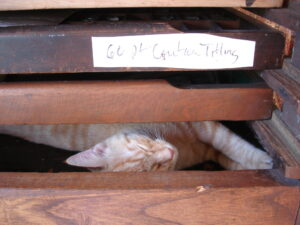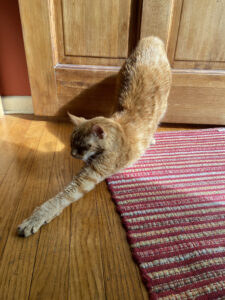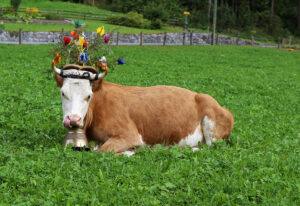This chapter of the Convivio Book of Days comes with a soundtrack. So, before you even begin reading the essay, I’d suggest you click on the following link and then click play. What you’ll hear is the music of Marin Marais: a collection recorded by Hille Perl & Lee Santana in 2004, called Pour la Violle et le Théorbe. The music is important. So go on: click, then click play, and then come back to the essay.
Good? Ok, then. Here we go:
And so it is autumn. The sunlight is again streaming through the glass front door, and this, for 18 years, has been a favorite thing of Haden’s, our ginger tabby affectionately known to so many of you as “Haden the Convivio Shop Cat.” Dappled sunlight began to stream in through the glass window since the month began, a hint of things to come, and there she’d be each day: paws pressed up against the glass, in as much of the sunlight as she could squeeze herself into. That streaming sunlight gets stronger with each passing day each autumn with the best of it coming always in November, and by then, she’d sometimes get positively drunk on the stuff, on her back, paws akimbo, or on her side, sunning one flank or the other, her orange striped coat glowing in that sunlight with such radiance. And her utter and complete joy in that warmth would make us glow with warmth, too: to see such complete enjoyment: such a thing of wonder.
It is a little more than a week now that Seth and I are without her. 18 years old, going on 19, and she was doing wonderfully but was having a tougher time of it since Labor Day, which is when we celebrated 18 years together, the day she chose to adopt us. Seth and I, Labor Day Weekend 2005: We drove to Safe Harbor Shelter in Jupiter with the idea that we’d seek out an old lazy male cat to maybe bring home with us. A cat set in his ways, mellow, a bit tired. Instead, this feisty young tomboy cat with orange stripes decided we should all be together. And she was absolutely right. She was resting in a hammock made from a bandana strung up in a cage, where she was bunking with a few other cats, and when the attendant fetched her and put her in Seth’s arms, she set about climbing up his chest. She was about 6 months old and they called her Cheyenne, which didn’t seem at all a proper name for her. We took her home and didn’t quite know what to call her, but soon decided to name her after the mango tree in our backyard. Orange mangoes, orange cat: the choice felt right. We called her Haden from then on, though we probably called her Kitty even more than we called her Haden, especially in these later years.
Here’s another item on the list of things Haden loved: the music of French composer Marin Marais, which you are listening to right now. Seth’s twin sister had been living with us for a little while when we brought Haden home. Sarah had moved here from California in August, and we brought Haden home with us on the Saturday of Labor Day Weekend, and then on Sunday, Sarah’s husband arrived, along with their two dogs: an Australian Shepherd called Buddy and Buddy’s pal Zoey, who always reminded me of George Rodrigue’s blue dog paintings. The timing wasn’t so great for temporary canine guests, but we decided to put Haden in the print shop and close up the glass door that led to it from the kitchen pantry. She knew there were dogs about, and she spent a lot of time that day sleeping in the space between two stacked wooden type cabinets.
To help put her at ease, I thought some gentle music would be a good idea. And so I put a fairly new CD from my collection on continuous repeat for the entire day: the very same music you are listening to now. From then on, this was Haden’s music. I don’t know if cats generally have favorite pieces of music, but I do think Haden did, and I feel like she knew this music was hers.
Eventually that Sunday, the two dogs and the cat regarded each other through the closed glass door. Kitty paws would eventually swipe under the door from one room to the other. By nightfall, we opened the door. Haden was extremely territorial and never liked seeing other cats around her home, but dogs she seemed to like. Buddy and Zoey became her pals, though Zoey never liked to look at Haden directly; she usually gave Haden a sideways glance and always seemed a bit intimidated by that cat.
Oh but she was the sweetest kitty. She had a bit of a reputation at the vet’s office, and she was not one you’d call “cuddly.” Haden was feisty all her years, independent, wanting to be near you but not smothered by your attention. She had the best personality. We’d go to bed each night and that’s when she’d begin hunting her little stuffed animals, her favorite (again, another favorite thing) being one we call “Cat in the Hat.” She’d pick him up in her mouth and carry him around the house, making loud kitty hunting noises, announcing her triumph. Overnight guests always needed to be warned that there would be kitty hunting going on as they slept: don’t be alarmed. When our home was broken into several years ago, we installed cameras throughout the property, including two inside the house, and thank God for the break-in: thanks to those cameras we have hours of entertaining footage of Haden hunting Cat in the Hat, making those wild kitty hunting noises. What we didn’t know until the cameras were installed: She did this not just when we went to bed, but each and every time we’d leave the house. Sometimes even when just one of us would leave: one of us would drive off, the hunting noises would begin, getting louder and louder, and then she’d walk into the room where you were and see you there and abruptly end the noise, spitting Cat in the Hat out of her mouth, onto the floor, before walking away nonchalantly.
Towards the end, I thought we’d have a couple of weeks to ponder how things would go, but in the overnight hours of the 15th of September, she suddenly seemed to have had enough of this world. She was very tired, her breathing labored. Friday morning, she spent a little time where the sunlight would be at the front door, then on her side on the wood floor, and then she made her way up to a perch she had claimed as her own: a chair, temporarily on its side. The chair was meant to be given away but she loved it there on its side. There was a blanket on the chair that was also meant to be given away. She burrowed into the blanket. The hospice vet came at 11, and the three of us were there with her, petting her as she slept calmly. Just being with her. The vet, who was so very kind, explained what would happen, and Seth & I, we allowed it to happen. Haden’s passage was so peaceful, so beautiful, and so very sad. She was at home, another thing she loved, and we were with her, and Cat in the Hat was with her, and the music of Marin Marais was in the air to ease her. She had, I think, all the things she loved around her: her home, her cat, her music, her family. And so she gently left this world.
Nothing is the same since she is gone. We miss her terribly and we always will. We have her music, and we have each other. But gosh, I do miss snuzzling into her orange stripes. She smelled so good, and I miss that. And I miss how wonderfully fuzzy she was, and her lovely personality. There was no better cat for us.
One week later, last Friday, we received word from her vet that Haden’s ashes had been delivered, and so we went. Haden’s ashes are in a lovely wooden box, engraved with her name and with her paw print. We cried some more, with the staff, and we played with their two office cats, Sebastian and Richard, as we cried, and with the new puppy that Chris, who cared for Haden since the beginning, had just gotten. After a long while, Seth and I collected ourselves and the little wooden box and left. I started the car and looked at the clock: 11:40. The same exact time she had died a week prior. All the things that had transpired over the course of her passage: I’ve come to feel like she directed it all. From the place on the perch where she chose to be, to us all being together, to the delivery of the ashes. Her way of saying, It’s ok. All is well. I think of that sweet ginger kitty and I count my blessings.
This Saturday, Seth & I will be installing an ofrenda, dedicated to Haden, at Hatch 1121, our local community arts center where Lake Worth’s Dia de Los Muertos festival will take place on Saturday, October 28. If you come to the festival, be sure to come see us in the courtyard, and be sure to view our kitty’s ofrenda inside the gallery. And always count your blessings. Be kind and thankful for all the ones you love: the time we have together is never long enough, is it?




